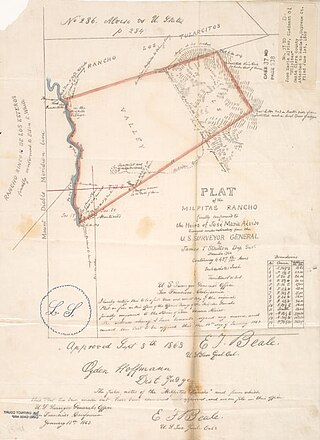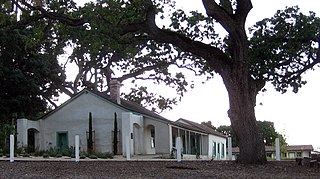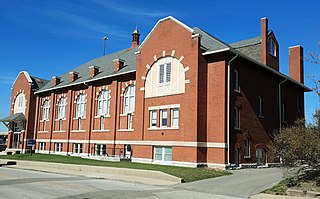
Alviso is a district of San Jose, California, located in North San Jose on the southern shores of San Francisco Bay. Originally an independent town, founded in 1852, today Alviso is San Jose's only waterfront district, primarily residential in nature, with several Silicon Valley tech companies and recreation-oriented businesses. Alviso is named after 19th-century Californio ranchero Ignacio Alviso, who owned the area as part of his Rancho Rincón de Los Esteros.

Rancho Milpitas was a 4,458-acre (18.04 km2) Mexican land grant in Santa Clara County, California. The name comes from the Nahuatl "milpan", a term meaning "in the field". Therefore, Milpitas could be translated as "little fields". The grant included what is now the city of Milpitas.

The José María Alviso Adobe, located in Milpitas, California, United States, was the home of José María Alviso, an early alcalde (mayor) of neighboring Pueblo de San Jose. It was built in 1837 and enlarged in the early 1850s, and stands as an excellent example of the Monterey Colonial style of architecture popularized throughout California in the 1830s and 1840s. It is the only remaining example of this style in the Santa Clara Valley and San Francisco Bay Area. The adobe is listed on the National Register of Historic Places.

The Hotel De Anza is a historic hotel in San Jose, California. At ten stories, it once was the tallest hotel in the San Jose central business district, prior to the construction of Hilton, Fairmont, and Marriott hotels. Significant for its architectural style, it is one of San Jose's few Zig Zag Moderne buildings. The hotel was listed on the National Register of Historic Places on January 21, 1982.

The Alviso Adobe Community Park is a 7-acre (2.8 ha) park in the city of Pleasanton, California, United States. It is built around an adobe house constructed in 1854 by Francisco Alviso on the Rancho Santa Rita Mexican Land Grant. The Alviso Adobe is a rare surviving example of an early American adobe that was continuously in use until 1969. The building is registered as California Historical Landmark #510 in 1954, but most of the historical marker was later found to be erroneous.

The former Plaza Theatre in Sydney, New South Wales is a heritage-listed building designed as a 2000-seat cinema by Eric Heath for the Hoyts Group, and opened in 1930. It is no longer used as a cinema.

This is intended to be a complete list of the properties and districts on the National Register of Historic Places in Santa Clara County, California, United States. Latitude and longitude coordinates are provided for many National Register properties and districts; these locations may be seen together in an online map.

The Athenæum, originally named Das Deutsche Haus, is the most ornate and best-preserved building affiliated with the German American community of Indianapolis. Once used as a German American Turnverein and clubhouse, it currently houses many groups, organizations, and businesses. The Athenæum is located across Massachusetts Avenue from the Old National Centre. It was placed on the National Register of Historic Places on February 21, 1973. On October 31, 2016, it was named the 41st National Historic Landmark in Indiana.

The Oxford Congregational Church and Cemetery is a historic church and cemetery in Oxford, Maine, located on the east side of King Street, 0.2 miles (0.32 km) north of its junction with Maine State Route 121. Built in 1842-3, the church is architecturally significant as a good local example of Greek Revival and Gothic Revival style, and is artistically significant for a decorative stenciled trompe-l'œil artwork on the ceiling and sanctuary end wall. The property was listed on the National Register of Historic Places in 1994.

The Sacramento Masonic Temple, built between 1913 and 1918, is a five-story building on J Street in downtown Sacramento, California. The building was listed on the National Register of Historic Places in 2001.

The Northwest Davenport Turner Society Hall is a historic building located in the old northwest side of Davenport, Iowa, United States. It has been listed on the National Register of Historic Places since 1979. The Northwest Davenport Turner Society Hall is significant for its association with Davenport's German community, which was the city's largest and most influential immigrant group. It also played an important role in the civic and cultural life of the northwest Davenport German community.

Saint John's Lutheran Church is an active church building located at 121 South Locust Street in the city of Adrian in Lenawee County, Michigan. It was designated as a Michigan State Historic State on February 23, 1981 and shortly after listed on the National Register of Historic Places on December 27, 1984. The Lutheran congregation moved to a new home in 2007, and the church building now houses the Reformed Baptist Church of Lenawee.

The International Vinegar Museum is located at 500 Main Street in Roslyn, South Dakota, United States. The museum is located in the former Roslyn Auditorium, a Depression-era brick building built in 1936 with funding from the Works Progress Administration. The building was listed on the National Register of Historic Places in 2001. The museum opened in 1999 and bills itself as the first museum dedicated to the subject of vinegar, with exhibits in its manufacture and use.

South Side Turnverein Hall is a historic social club and gymnasium in the Bates-Hendricks neighborhood of Indianapolis, Indiana, affiliated with the city's German-American community. It was built in 1900 by prominent architects Vonnegut & Bohn, whose managing partners Bernard Vonnegut, Sr. and Arthur Bohn were members of the burgeoning German-American community in Indianapolis. The architects were also known for designing the Athenæum, another German-American social club in the city. The South Side Turnverein was an important gathering place for Indianapolis' south side German community until its decline in the 1940s. It was sold to investors in 1978 to be used as an athletic club.

Saratoga Village Library, formerly known as the Saratoga Library, is a historic building in Saratoga, California designed by architect Eldridge T. Spencer in 1927. The building is historically significant due to its long association with the development of civic life of Saratoga throughout the 20th century, serving as the only library for the community for 51 years. The Saratoga Village Library was placed on the National Register of Historic Places on January 17, 2007. In 1978, the completion of a new Saratoga Library was established on Saratoga Avenue and Fruitvale. The design was also the work of Spencer.

Saratoga Foothill Club, also known as the Foothill Clubhouse, is a building located in Saratoga, California. The club was placed on the National Register of Historic Places on February 27, 2005.

The Earl and Virginia Young House, also known as the Young-Sartorette House, stands as a historic residence in Campbell, California. Constructed in 1928, it served as the home for Earl Young, a successful orchard farmer in the Santa Clara Valley, and his family. The house is historically significant in the Tudor Revival architectural style, which gained popularity in the mid-twentieth century. In 1981, the Herz family relocated both the house and garage to prevent them from potential demolition. The Young-Sartorette House was placed on the National Register of Historic Places on January 8, 2009.

Welch-Hurst, also known as the Judge J.R. Welch's Ranch, is a historic gentleman's working ranch and family retreat in Saratoga, California. This ranch represents an early example of American Craftsman-style architectural, built for Judge James R. Welch. The Welch-Hurst ranch was placed on the National Register of Historic Places on September 18, 1978.

The Messina Orchard is a historic orchard, located in San Jose, California, US. The 4.96 acres (2.01 ha) tract of land has two residences associated with the Messina family. It holds significance in the realm of agriculture for its connection to the agricultural growth of the Santa Clara Valley, as well as for its architectural value due to the presence of two period-revival family homes. The Messina Orchard was officially recognized and listed on the National Register of Historic Places on April 9, 2018.

Sonoma Valley Woman's Club is a historic woman's clubhouse located in Sonoma, California. It was founded in 1901 by eleven local women led by Martha Stearns. Built in 1916, the club was designed by architect Brainerd Jones from Petaluma and plays a role in the civic development of Sonoma. The Woman's Club was listed on the National Register of Historic Places on January 7, 2015.
























